Nursing Case Study Analysis (Gian Bacci)
VerifiedAdded on 2023/01/16
|11
|3154
|72
AI Summary
This assignment discusses the post-operative care process for a patient who has undergone a surgery for her diabetic foot ulcer. It provides a pathophysiological description of her wound status, nursing priorities, and management strategies for wound infection.
Contribute Materials
Your contribution can guide someone’s learning journey. Share your
documents today.

Running head: CASE STUDY ANALYSIS
NURSING CASE STUDY ANALYSIS (GIAN BACCI)
Name of the student
Name of the university
Author note
NURSING CASE STUDY ANALYSIS (GIAN BACCI)
Name of the student
Name of the university
Author note
Secure Best Marks with AI Grader
Need help grading? Try our AI Grader for instant feedback on your assignments.

1CASE STUDY ANALYSIS
Introduction
Post-operative care process is one of the crucial phases of healthcare intervention as
care process for patients suffering from post-operative wounds and incision requires
continuous monitoring observation and evaluation for their wounds (Bellelli et al., 2014).
This assignment discusses about one such patient Gina Bacci (49) who has undergone a
surgery for her diabetic foot ulcer and as intervention; the healthcare professionals have
amputated her forefoot. Hence, the primary aim of this assignment is to provide a
pathophysiological description of her wound status and in this aspect tow nursing priorities
for the patient would be discussed. Finally, with handling and management strategies of her
wound, the risk of her wound infection and preventive measurements would be discussed.
Underlying pathophysiology and causes of her current post-operative wound status
The provided case study of Mrs. Gina Bacci (49) mentions about her post-operative
care process. She undergone her forefoot amputation surgery 2 weeks ago due to her diabetic
foot ulcer condition and was discharged after her surgery. However, 2 weeks later she has
visited the outpatient service of the healthcare facility for her sore, red- swollen and painful
wound condition. Upon primary observation, it was seen that her wound is swollen and
reddish with broken sutures and sloughy tissues coming out of the incision site. Further, it
was also seen that the wound of the patient is leaking serous exudates and is painful.
Therefore, to understand the pathophysiology associated to the wound health and risk of
infection for Mrs. Bacci, the immunological steps of wound healing should be discussed. As
per Olczyk, Mencner and Komosinska-Vassev (2014), there are three steps of wound healing
such as inflammation, proliferation and maturation, through which every wound progresses to
heal. As per Zhao et al. (2017), Mrs. Bacci’s wound appeared red and swollen, it could be the
natural inflammation technique of the body to prevent the occurrence of wound infection. In
Introduction
Post-operative care process is one of the crucial phases of healthcare intervention as
care process for patients suffering from post-operative wounds and incision requires
continuous monitoring observation and evaluation for their wounds (Bellelli et al., 2014).
This assignment discusses about one such patient Gina Bacci (49) who has undergone a
surgery for her diabetic foot ulcer and as intervention; the healthcare professionals have
amputated her forefoot. Hence, the primary aim of this assignment is to provide a
pathophysiological description of her wound status and in this aspect tow nursing priorities
for the patient would be discussed. Finally, with handling and management strategies of her
wound, the risk of her wound infection and preventive measurements would be discussed.
Underlying pathophysiology and causes of her current post-operative wound status
The provided case study of Mrs. Gina Bacci (49) mentions about her post-operative
care process. She undergone her forefoot amputation surgery 2 weeks ago due to her diabetic
foot ulcer condition and was discharged after her surgery. However, 2 weeks later she has
visited the outpatient service of the healthcare facility for her sore, red- swollen and painful
wound condition. Upon primary observation, it was seen that her wound is swollen and
reddish with broken sutures and sloughy tissues coming out of the incision site. Further, it
was also seen that the wound of the patient is leaking serous exudates and is painful.
Therefore, to understand the pathophysiology associated to the wound health and risk of
infection for Mrs. Bacci, the immunological steps of wound healing should be discussed. As
per Olczyk, Mencner and Komosinska-Vassev (2014), there are three steps of wound healing
such as inflammation, proliferation and maturation, through which every wound progresses to
heal. As per Zhao et al. (2017), Mrs. Bacci’s wound appeared red and swollen, it could be the
natural inflammation technique of the body to prevent the occurrence of wound infection. In
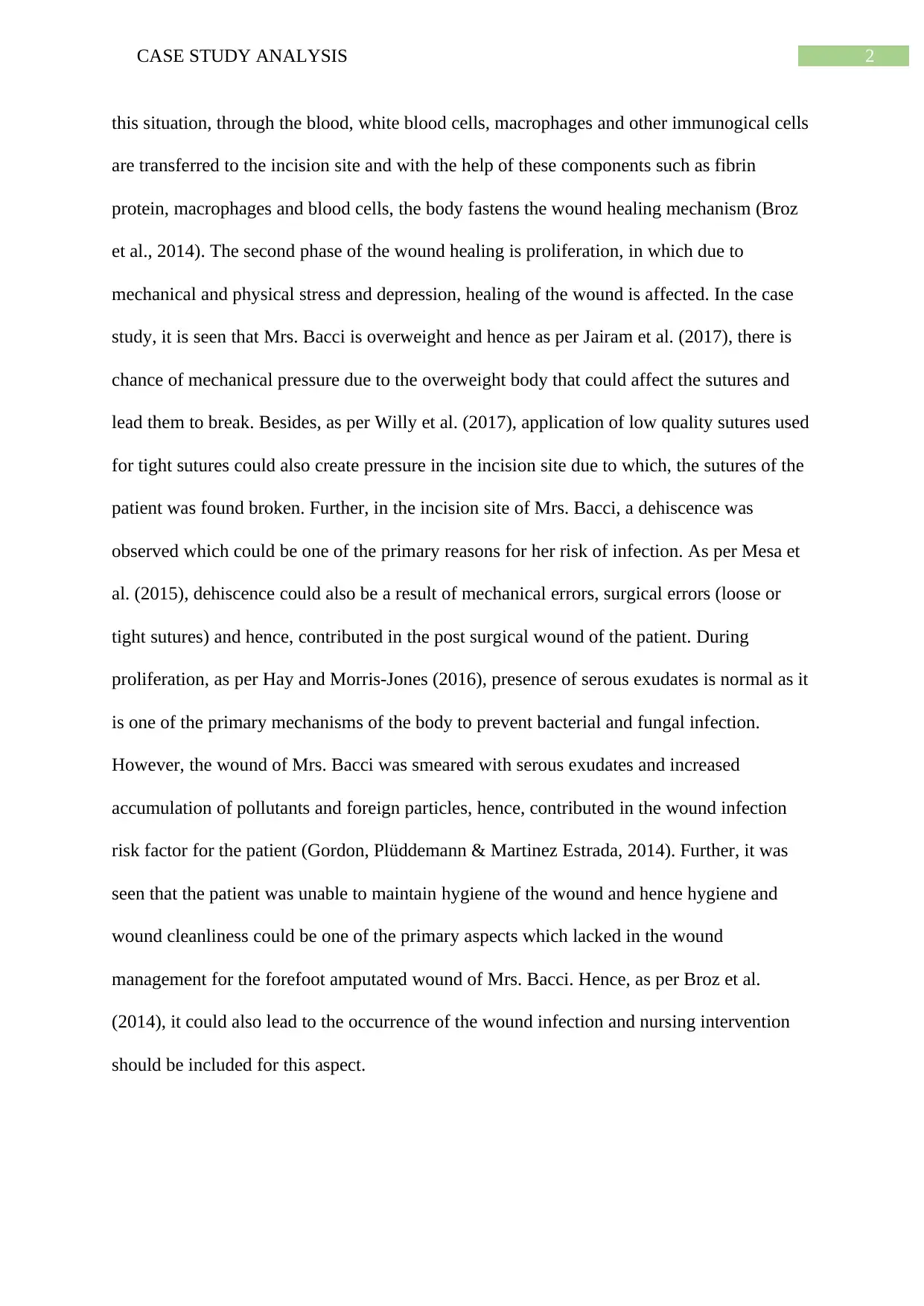
2CASE STUDY ANALYSIS
this situation, through the blood, white blood cells, macrophages and other immunogical cells
are transferred to the incision site and with the help of these components such as fibrin
protein, macrophages and blood cells, the body fastens the wound healing mechanism (Broz
et al., 2014). The second phase of the wound healing is proliferation, in which due to
mechanical and physical stress and depression, healing of the wound is affected. In the case
study, it is seen that Mrs. Bacci is overweight and hence as per Jairam et al. (2017), there is
chance of mechanical pressure due to the overweight body that could affect the sutures and
lead them to break. Besides, as per Willy et al. (2017), application of low quality sutures used
for tight sutures could also create pressure in the incision site due to which, the sutures of the
patient was found broken. Further, in the incision site of Mrs. Bacci, a dehiscence was
observed which could be one of the primary reasons for her risk of infection. As per Mesa et
al. (2015), dehiscence could also be a result of mechanical errors, surgical errors (loose or
tight sutures) and hence, contributed in the post surgical wound of the patient. During
proliferation, as per Hay and Morris‐Jones (2016), presence of serous exudates is normal as it
is one of the primary mechanisms of the body to prevent bacterial and fungal infection.
However, the wound of Mrs. Bacci was smeared with serous exudates and increased
accumulation of pollutants and foreign particles, hence, contributed in the wound infection
risk factor for the patient (Gordon, Plüddemann & Martinez Estrada, 2014). Further, it was
seen that the patient was unable to maintain hygiene of the wound and hence hygiene and
wound cleanliness could be one of the primary aspects which lacked in the wound
management for the forefoot amputated wound of Mrs. Bacci. Hence, as per Broz et al.
(2014), it could also lead to the occurrence of the wound infection and nursing intervention
should be included for this aspect.
this situation, through the blood, white blood cells, macrophages and other immunogical cells
are transferred to the incision site and with the help of these components such as fibrin
protein, macrophages and blood cells, the body fastens the wound healing mechanism (Broz
et al., 2014). The second phase of the wound healing is proliferation, in which due to
mechanical and physical stress and depression, healing of the wound is affected. In the case
study, it is seen that Mrs. Bacci is overweight and hence as per Jairam et al. (2017), there is
chance of mechanical pressure due to the overweight body that could affect the sutures and
lead them to break. Besides, as per Willy et al. (2017), application of low quality sutures used
for tight sutures could also create pressure in the incision site due to which, the sutures of the
patient was found broken. Further, in the incision site of Mrs. Bacci, a dehiscence was
observed which could be one of the primary reasons for her risk of infection. As per Mesa et
al. (2015), dehiscence could also be a result of mechanical errors, surgical errors (loose or
tight sutures) and hence, contributed in the post surgical wound of the patient. During
proliferation, as per Hay and Morris‐Jones (2016), presence of serous exudates is normal as it
is one of the primary mechanisms of the body to prevent bacterial and fungal infection.
However, the wound of Mrs. Bacci was smeared with serous exudates and increased
accumulation of pollutants and foreign particles, hence, contributed in the wound infection
risk factor for the patient (Gordon, Plüddemann & Martinez Estrada, 2014). Further, it was
seen that the patient was unable to maintain hygiene of the wound and hence hygiene and
wound cleanliness could be one of the primary aspects which lacked in the wound
management for the forefoot amputated wound of Mrs. Bacci. Hence, as per Broz et al.
(2014), it could also lead to the occurrence of the wound infection and nursing intervention
should be included for this aspect.
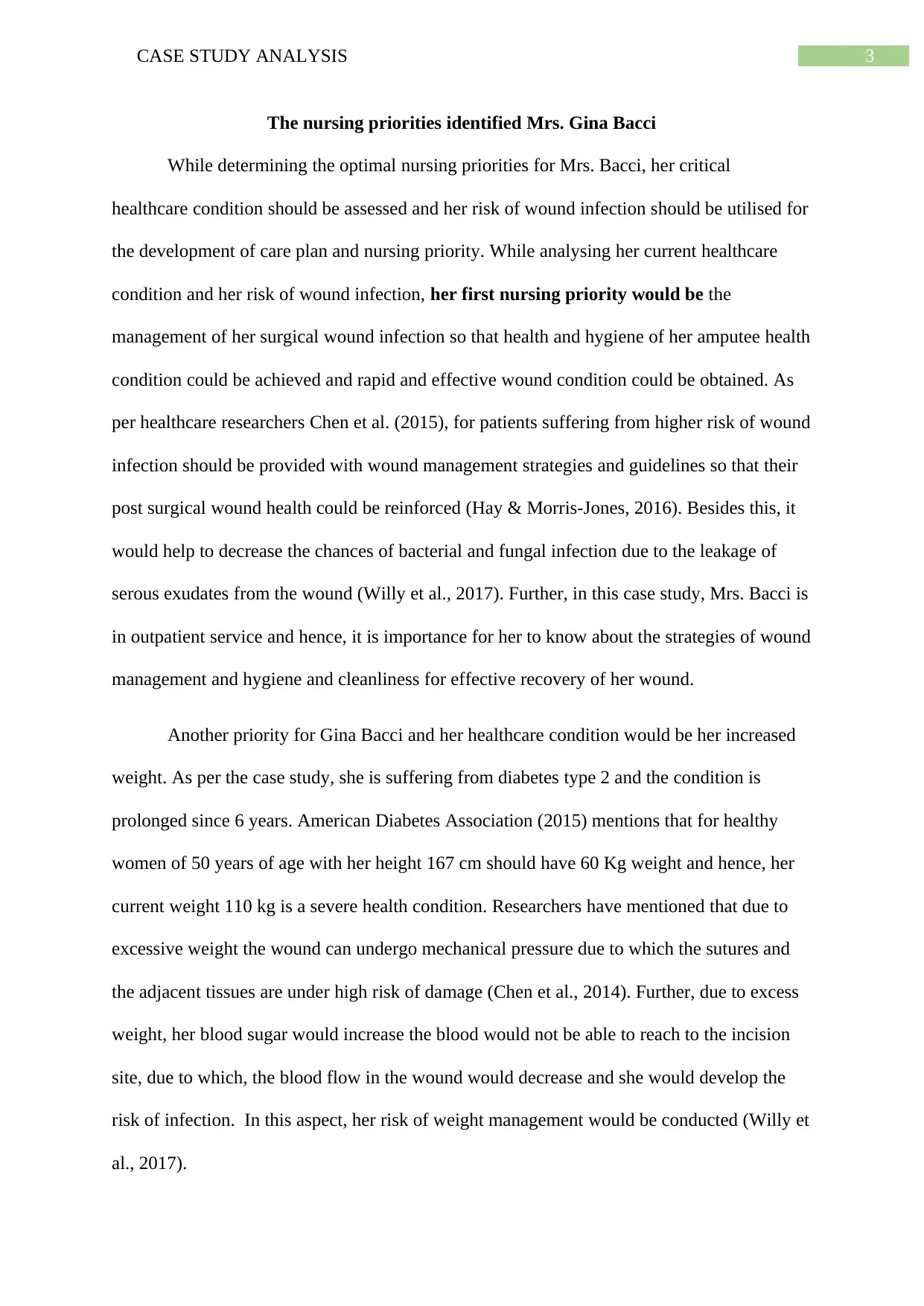
3CASE STUDY ANALYSIS
The nursing priorities identified Mrs. Gina Bacci
While determining the optimal nursing priorities for Mrs. Bacci, her critical
healthcare condition should be assessed and her risk of wound infection should be utilised for
the development of care plan and nursing priority. While analysing her current healthcare
condition and her risk of wound infection, her first nursing priority would be the
management of her surgical wound infection so that health and hygiene of her amputee health
condition could be achieved and rapid and effective wound condition could be obtained. As
per healthcare researchers Chen et al. (2015), for patients suffering from higher risk of wound
infection should be provided with wound management strategies and guidelines so that their
post surgical wound health could be reinforced (Hay & Morris‐Jones, 2016). Besides this, it
would help to decrease the chances of bacterial and fungal infection due to the leakage of
serous exudates from the wound (Willy et al., 2017). Further, in this case study, Mrs. Bacci is
in outpatient service and hence, it is importance for her to know about the strategies of wound
management and hygiene and cleanliness for effective recovery of her wound.
Another priority for Gina Bacci and her healthcare condition would be her increased
weight. As per the case study, she is suffering from diabetes type 2 and the condition is
prolonged since 6 years. American Diabetes Association (2015) mentions that for healthy
women of 50 years of age with her height 167 cm should have 60 Kg weight and hence, her
current weight 110 kg is a severe health condition. Researchers have mentioned that due to
excessive weight the wound can undergo mechanical pressure due to which the sutures and
the adjacent tissues are under high risk of damage (Chen et al., 2014). Further, due to excess
weight, her blood sugar would increase the blood would not be able to reach to the incision
site, due to which, the blood flow in the wound would decrease and she would develop the
risk of infection. In this aspect, her risk of weight management would be conducted (Willy et
al., 2017).
The nursing priorities identified Mrs. Gina Bacci
While determining the optimal nursing priorities for Mrs. Bacci, her critical
healthcare condition should be assessed and her risk of wound infection should be utilised for
the development of care plan and nursing priority. While analysing her current healthcare
condition and her risk of wound infection, her first nursing priority would be the
management of her surgical wound infection so that health and hygiene of her amputee health
condition could be achieved and rapid and effective wound condition could be obtained. As
per healthcare researchers Chen et al. (2015), for patients suffering from higher risk of wound
infection should be provided with wound management strategies and guidelines so that their
post surgical wound health could be reinforced (Hay & Morris‐Jones, 2016). Besides this, it
would help to decrease the chances of bacterial and fungal infection due to the leakage of
serous exudates from the wound (Willy et al., 2017). Further, in this case study, Mrs. Bacci is
in outpatient service and hence, it is importance for her to know about the strategies of wound
management and hygiene and cleanliness for effective recovery of her wound.
Another priority for Gina Bacci and her healthcare condition would be her increased
weight. As per the case study, she is suffering from diabetes type 2 and the condition is
prolonged since 6 years. American Diabetes Association (2015) mentions that for healthy
women of 50 years of age with her height 167 cm should have 60 Kg weight and hence, her
current weight 110 kg is a severe health condition. Researchers have mentioned that due to
excessive weight the wound can undergo mechanical pressure due to which the sutures and
the adjacent tissues are under high risk of damage (Chen et al., 2014). Further, due to excess
weight, her blood sugar would increase the blood would not be able to reach to the incision
site, due to which, the blood flow in the wound would decrease and she would develop the
risk of infection. In this aspect, her risk of weight management would be conducted (Willy et
al., 2017).
Secure Best Marks with AI Grader
Need help grading? Try our AI Grader for instant feedback on your assignments.
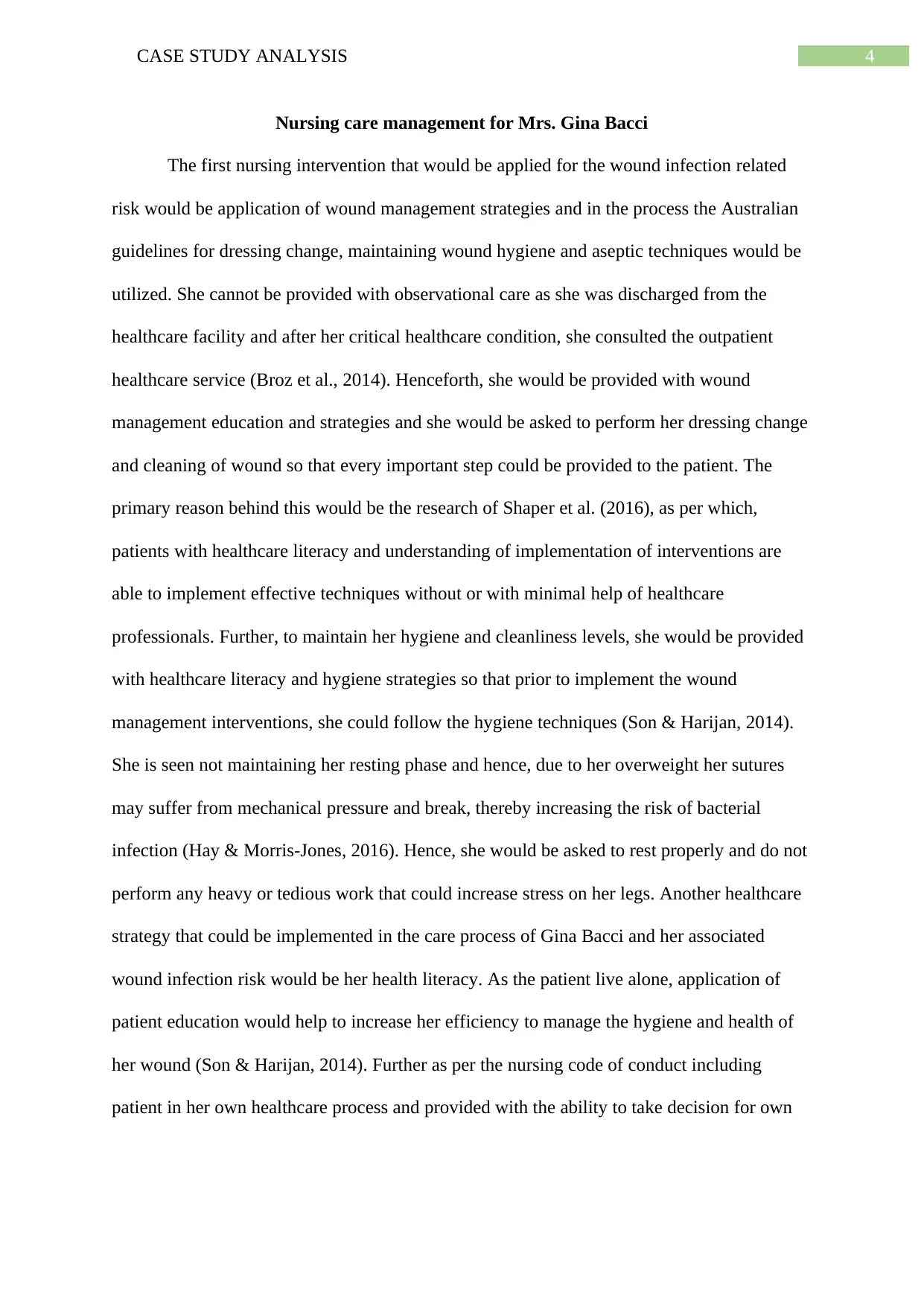
4CASE STUDY ANALYSIS
Nursing care management for Mrs. Gina Bacci
The first nursing intervention that would be applied for the wound infection related
risk would be application of wound management strategies and in the process the Australian
guidelines for dressing change, maintaining wound hygiene and aseptic techniques would be
utilized. She cannot be provided with observational care as she was discharged from the
healthcare facility and after her critical healthcare condition, she consulted the outpatient
healthcare service (Broz et al., 2014). Henceforth, she would be provided with wound
management education and strategies and she would be asked to perform her dressing change
and cleaning of wound so that every important step could be provided to the patient. The
primary reason behind this would be the research of Shaper et al. (2016), as per which,
patients with healthcare literacy and understanding of implementation of interventions are
able to implement effective techniques without or with minimal help of healthcare
professionals. Further, to maintain her hygiene and cleanliness levels, she would be provided
with healthcare literacy and hygiene strategies so that prior to implement the wound
management interventions, she could follow the hygiene techniques (Son & Harijan, 2014).
She is seen not maintaining her resting phase and hence, due to her overweight her sutures
may suffer from mechanical pressure and break, thereby increasing the risk of bacterial
infection (Hay & Morris‐Jones, 2016). Hence, she would be asked to rest properly and do not
perform any heavy or tedious work that could increase stress on her legs. Another healthcare
strategy that could be implemented in the care process of Gina Bacci and her associated
wound infection risk would be her health literacy. As the patient live alone, application of
patient education would help to increase her efficiency to manage the hygiene and health of
her wound (Son & Harijan, 2014). Further as per the nursing code of conduct including
patient in her own healthcare process and provided with the ability to take decision for own
Nursing care management for Mrs. Gina Bacci
The first nursing intervention that would be applied for the wound infection related
risk would be application of wound management strategies and in the process the Australian
guidelines for dressing change, maintaining wound hygiene and aseptic techniques would be
utilized. She cannot be provided with observational care as she was discharged from the
healthcare facility and after her critical healthcare condition, she consulted the outpatient
healthcare service (Broz et al., 2014). Henceforth, she would be provided with wound
management education and strategies and she would be asked to perform her dressing change
and cleaning of wound so that every important step could be provided to the patient. The
primary reason behind this would be the research of Shaper et al. (2016), as per which,
patients with healthcare literacy and understanding of implementation of interventions are
able to implement effective techniques without or with minimal help of healthcare
professionals. Further, to maintain her hygiene and cleanliness levels, she would be provided
with healthcare literacy and hygiene strategies so that prior to implement the wound
management interventions, she could follow the hygiene techniques (Son & Harijan, 2014).
She is seen not maintaining her resting phase and hence, due to her overweight her sutures
may suffer from mechanical pressure and break, thereby increasing the risk of bacterial
infection (Hay & Morris‐Jones, 2016). Hence, she would be asked to rest properly and do not
perform any heavy or tedious work that could increase stress on her legs. Another healthcare
strategy that could be implemented in the care process of Gina Bacci and her associated
wound infection risk would be her health literacy. As the patient live alone, application of
patient education would help to increase her efficiency to manage the hygiene and health of
her wound (Son & Harijan, 2014). Further as per the nursing code of conduct including
patient in her own healthcare process and provided with the ability to take decision for own
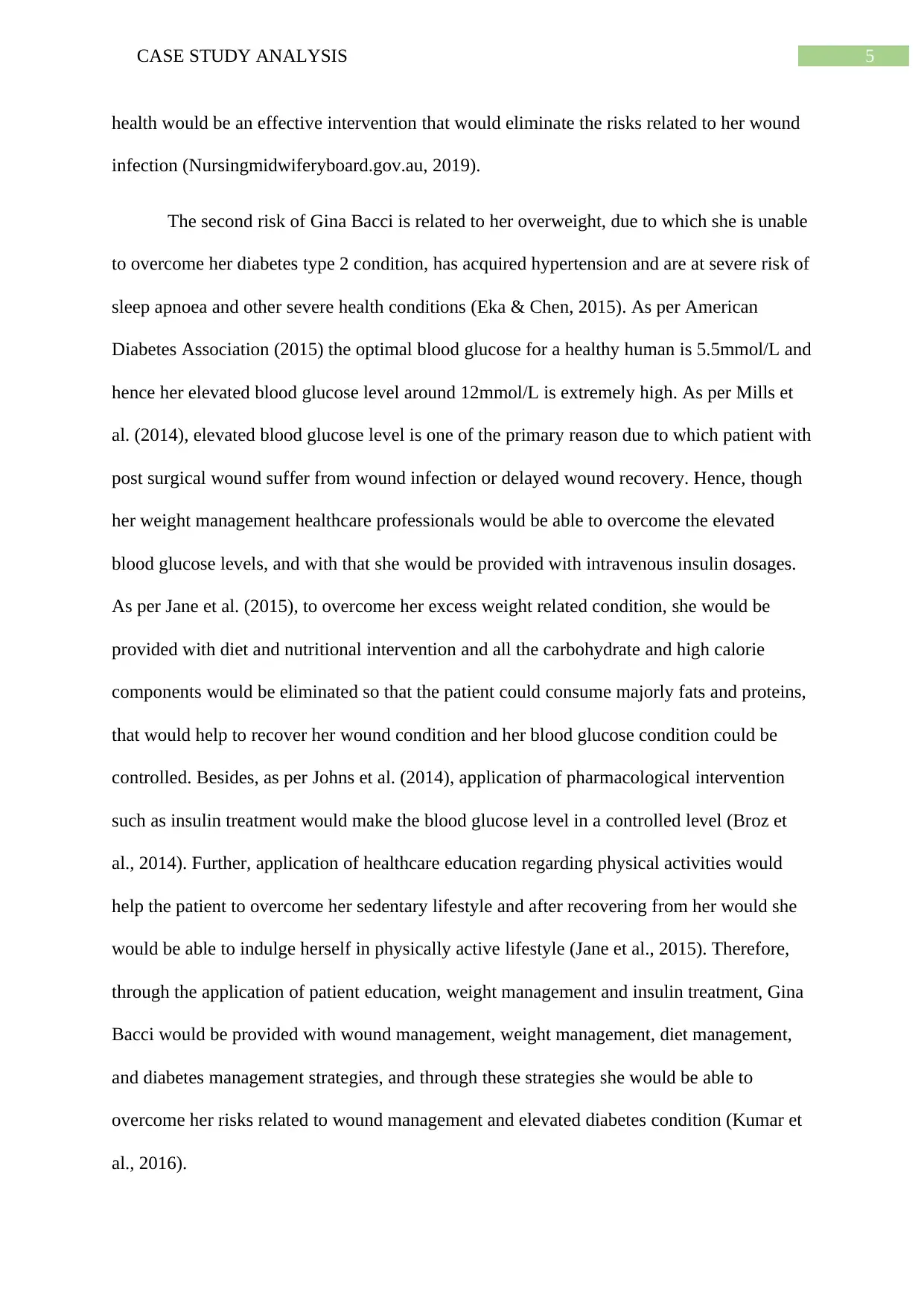
5CASE STUDY ANALYSIS
health would be an effective intervention that would eliminate the risks related to her wound
infection (Nursingmidwiferyboard.gov.au, 2019).
The second risk of Gina Bacci is related to her overweight, due to which she is unable
to overcome her diabetes type 2 condition, has acquired hypertension and are at severe risk of
sleep apnoea and other severe health conditions (Eka & Chen, 2015). As per American
Diabetes Association (2015) the optimal blood glucose for a healthy human is 5.5mmol/L and
hence her elevated blood glucose level around 12mmol/L is extremely high. As per Mills et
al. (2014), elevated blood glucose level is one of the primary reason due to which patient with
post surgical wound suffer from wound infection or delayed wound recovery. Hence, though
her weight management healthcare professionals would be able to overcome the elevated
blood glucose levels, and with that she would be provided with intravenous insulin dosages.
As per Jane et al. (2015), to overcome her excess weight related condition, she would be
provided with diet and nutritional intervention and all the carbohydrate and high calorie
components would be eliminated so that the patient could consume majorly fats and proteins,
that would help to recover her wound condition and her blood glucose condition could be
controlled. Besides, as per Johns et al. (2014), application of pharmacological intervention
such as insulin treatment would make the blood glucose level in a controlled level (Broz et
al., 2014). Further, application of healthcare education regarding physical activities would
help the patient to overcome her sedentary lifestyle and after recovering from her would she
would be able to indulge herself in physically active lifestyle (Jane et al., 2015). Therefore,
through the application of patient education, weight management and insulin treatment, Gina
Bacci would be provided with wound management, weight management, diet management,
and diabetes management strategies, and through these strategies she would be able to
overcome her risks related to wound management and elevated diabetes condition (Kumar et
al., 2016).
health would be an effective intervention that would eliminate the risks related to her wound
infection (Nursingmidwiferyboard.gov.au, 2019).
The second risk of Gina Bacci is related to her overweight, due to which she is unable
to overcome her diabetes type 2 condition, has acquired hypertension and are at severe risk of
sleep apnoea and other severe health conditions (Eka & Chen, 2015). As per American
Diabetes Association (2015) the optimal blood glucose for a healthy human is 5.5mmol/L and
hence her elevated blood glucose level around 12mmol/L is extremely high. As per Mills et
al. (2014), elevated blood glucose level is one of the primary reason due to which patient with
post surgical wound suffer from wound infection or delayed wound recovery. Hence, though
her weight management healthcare professionals would be able to overcome the elevated
blood glucose levels, and with that she would be provided with intravenous insulin dosages.
As per Jane et al. (2015), to overcome her excess weight related condition, she would be
provided with diet and nutritional intervention and all the carbohydrate and high calorie
components would be eliminated so that the patient could consume majorly fats and proteins,
that would help to recover her wound condition and her blood glucose condition could be
controlled. Besides, as per Johns et al. (2014), application of pharmacological intervention
such as insulin treatment would make the blood glucose level in a controlled level (Broz et
al., 2014). Further, application of healthcare education regarding physical activities would
help the patient to overcome her sedentary lifestyle and after recovering from her would she
would be able to indulge herself in physically active lifestyle (Jane et al., 2015). Therefore,
through the application of patient education, weight management and insulin treatment, Gina
Bacci would be provided with wound management, weight management, diet management,
and diabetes management strategies, and through these strategies she would be able to
overcome her risks related to wound management and elevated diabetes condition (Kumar et
al., 2016).
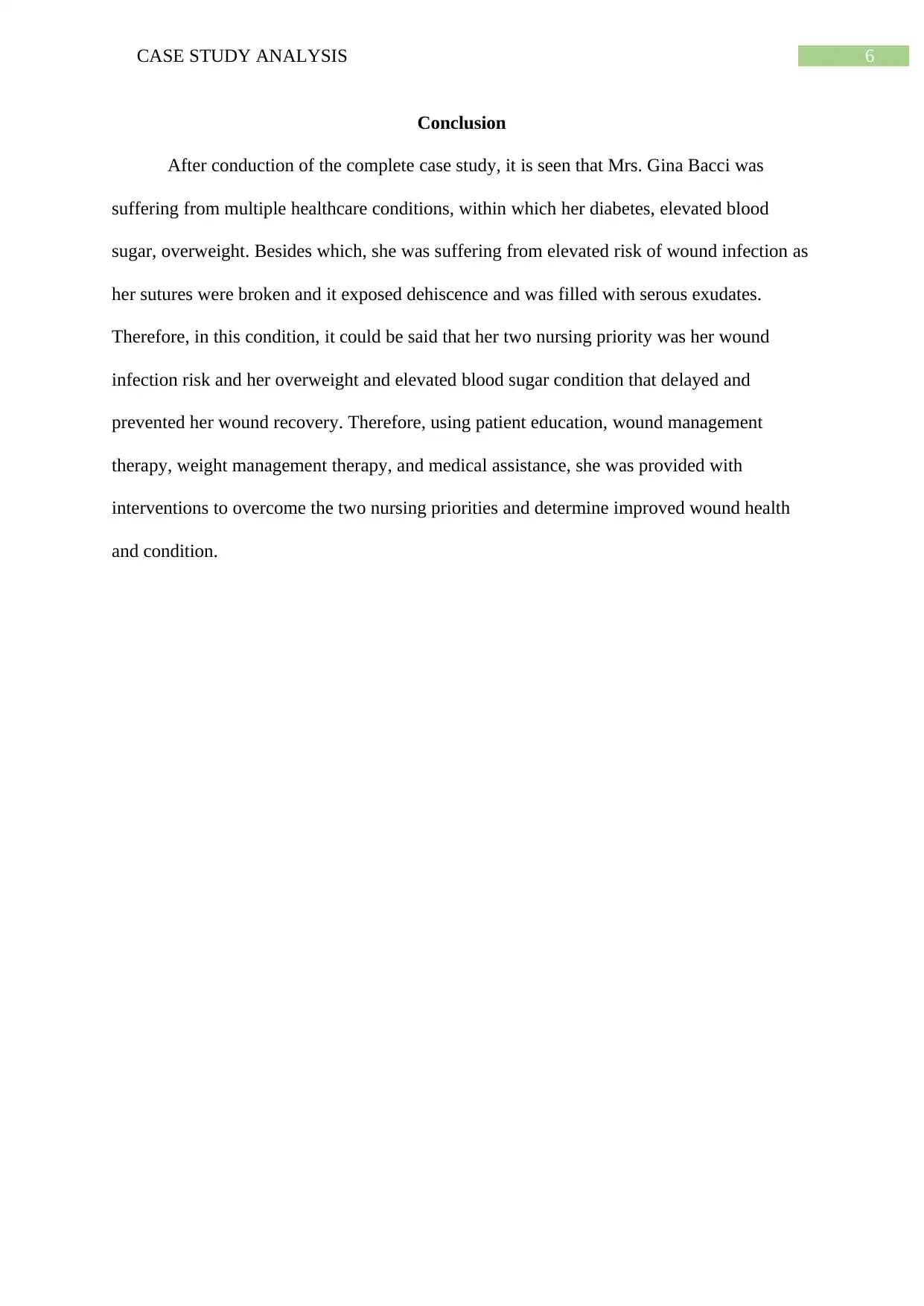
6CASE STUDY ANALYSIS
Conclusion
After conduction of the complete case study, it is seen that Mrs. Gina Bacci was
suffering from multiple healthcare conditions, within which her diabetes, elevated blood
sugar, overweight. Besides which, she was suffering from elevated risk of wound infection as
her sutures were broken and it exposed dehiscence and was filled with serous exudates.
Therefore, in this condition, it could be said that her two nursing priority was her wound
infection risk and her overweight and elevated blood sugar condition that delayed and
prevented her wound recovery. Therefore, using patient education, wound management
therapy, weight management therapy, and medical assistance, she was provided with
interventions to overcome the two nursing priorities and determine improved wound health
and condition.
Conclusion
After conduction of the complete case study, it is seen that Mrs. Gina Bacci was
suffering from multiple healthcare conditions, within which her diabetes, elevated blood
sugar, overweight. Besides which, she was suffering from elevated risk of wound infection as
her sutures were broken and it exposed dehiscence and was filled with serous exudates.
Therefore, in this condition, it could be said that her two nursing priority was her wound
infection risk and her overweight and elevated blood sugar condition that delayed and
prevented her wound recovery. Therefore, using patient education, wound management
therapy, weight management therapy, and medical assistance, she was provided with
interventions to overcome the two nursing priorities and determine improved wound health
and condition.
Paraphrase This Document
Need a fresh take? Get an instant paraphrase of this document with our AI Paraphraser
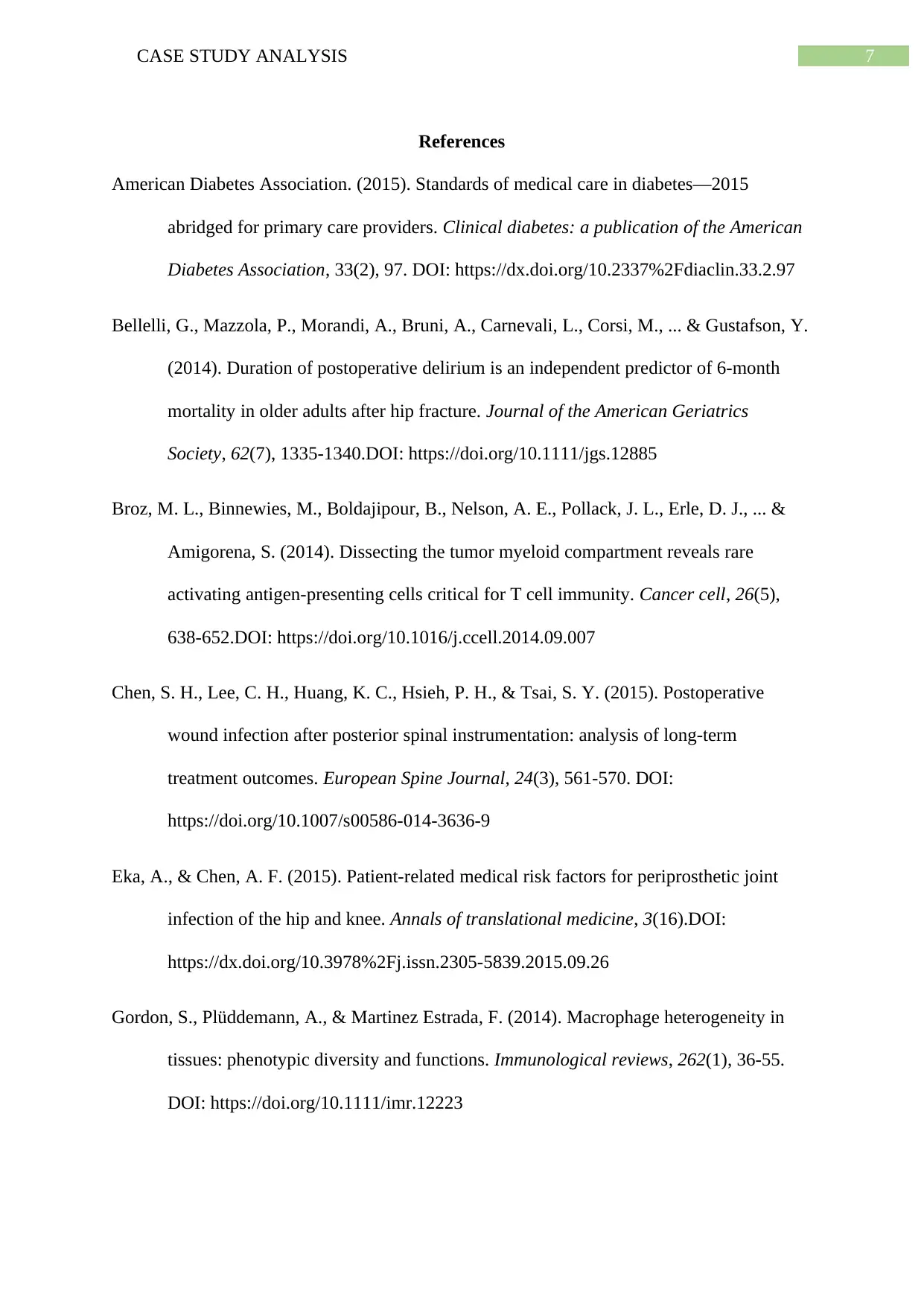
7CASE STUDY ANALYSIS
References
American Diabetes Association. (2015). Standards of medical care in diabetes—2015
abridged for primary care providers. Clinical diabetes: a publication of the American
Diabetes Association, 33(2), 97. DOI: https://dx.doi.org/10.2337%2Fdiaclin.33.2.97
Bellelli, G., Mazzola, P., Morandi, A., Bruni, A., Carnevali, L., Corsi, M., ... & Gustafson, Y.
(2014). Duration of postoperative delirium is an independent predictor of 6‐month
mortality in older adults after hip fracture. Journal of the American Geriatrics
Society, 62(7), 1335-1340.DOI: https://doi.org/10.1111/jgs.12885
Broz, M. L., Binnewies, M., Boldajipour, B., Nelson, A. E., Pollack, J. L., Erle, D. J., ... &
Amigorena, S. (2014). Dissecting the tumor myeloid compartment reveals rare
activating antigen-presenting cells critical for T cell immunity. Cancer cell, 26(5),
638-652.DOI: https://doi.org/10.1016/j.ccell.2014.09.007
Chen, S. H., Lee, C. H., Huang, K. C., Hsieh, P. H., & Tsai, S. Y. (2015). Postoperative
wound infection after posterior spinal instrumentation: analysis of long-term
treatment outcomes. European Spine Journal, 24(3), 561-570. DOI:
https://doi.org/10.1007/s00586-014-3636-9
Eka, A., & Chen, A. F. (2015). Patient-related medical risk factors for periprosthetic joint
infection of the hip and knee. Annals of translational medicine, 3(16).DOI:
https://dx.doi.org/10.3978%2Fj.issn.2305-5839.2015.09.26
Gordon, S., Plüddemann, A., & Martinez Estrada, F. (2014). Macrophage heterogeneity in
tissues: phenotypic diversity and functions. Immunological reviews, 262(1), 36-55.
DOI: https://doi.org/10.1111/imr.12223
References
American Diabetes Association. (2015). Standards of medical care in diabetes—2015
abridged for primary care providers. Clinical diabetes: a publication of the American
Diabetes Association, 33(2), 97. DOI: https://dx.doi.org/10.2337%2Fdiaclin.33.2.97
Bellelli, G., Mazzola, P., Morandi, A., Bruni, A., Carnevali, L., Corsi, M., ... & Gustafson, Y.
(2014). Duration of postoperative delirium is an independent predictor of 6‐month
mortality in older adults after hip fracture. Journal of the American Geriatrics
Society, 62(7), 1335-1340.DOI: https://doi.org/10.1111/jgs.12885
Broz, M. L., Binnewies, M., Boldajipour, B., Nelson, A. E., Pollack, J. L., Erle, D. J., ... &
Amigorena, S. (2014). Dissecting the tumor myeloid compartment reveals rare
activating antigen-presenting cells critical for T cell immunity. Cancer cell, 26(5),
638-652.DOI: https://doi.org/10.1016/j.ccell.2014.09.007
Chen, S. H., Lee, C. H., Huang, K. C., Hsieh, P. H., & Tsai, S. Y. (2015). Postoperative
wound infection after posterior spinal instrumentation: analysis of long-term
treatment outcomes. European Spine Journal, 24(3), 561-570. DOI:
https://doi.org/10.1007/s00586-014-3636-9
Eka, A., & Chen, A. F. (2015). Patient-related medical risk factors for periprosthetic joint
infection of the hip and knee. Annals of translational medicine, 3(16).DOI:
https://dx.doi.org/10.3978%2Fj.issn.2305-5839.2015.09.26
Gordon, S., Plüddemann, A., & Martinez Estrada, F. (2014). Macrophage heterogeneity in
tissues: phenotypic diversity and functions. Immunological reviews, 262(1), 36-55.
DOI: https://doi.org/10.1111/imr.12223
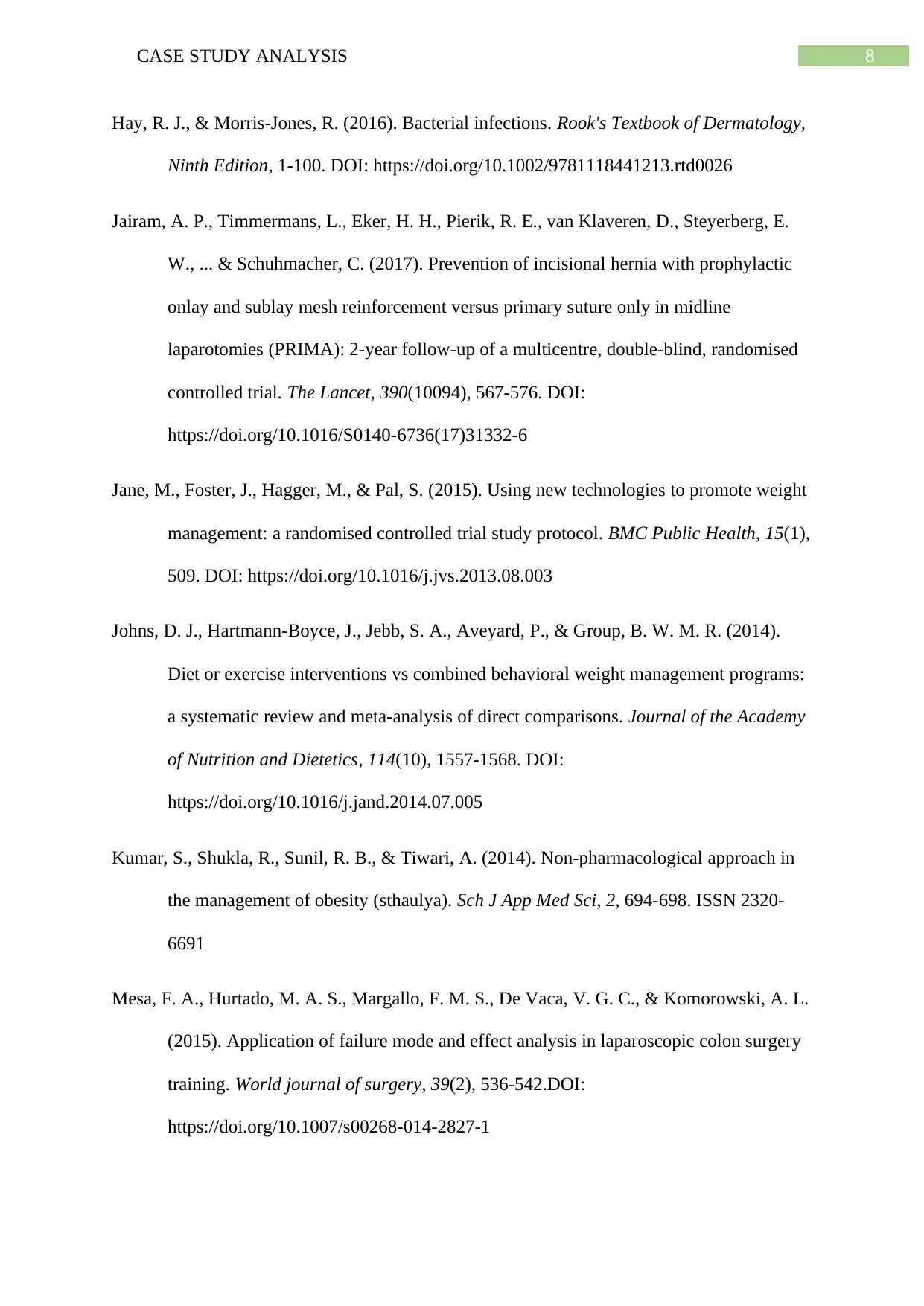
8CASE STUDY ANALYSIS
Hay, R. J., & Morris‐Jones, R. (2016). Bacterial infections. Rook's Textbook of Dermatology,
Ninth Edition, 1-100. DOI: https://doi.org/10.1002/9781118441213.rtd0026
Jairam, A. P., Timmermans, L., Eker, H. H., Pierik, R. E., van Klaveren, D., Steyerberg, E.
W., ... & Schuhmacher, C. (2017). Prevention of incisional hernia with prophylactic
onlay and sublay mesh reinforcement versus primary suture only in midline
laparotomies (PRIMA): 2-year follow-up of a multicentre, double-blind, randomised
controlled trial. The Lancet, 390(10094), 567-576. DOI:
https://doi.org/10.1016/S0140-6736(17)31332-6
Jane, M., Foster, J., Hagger, M., & Pal, S. (2015). Using new technologies to promote weight
management: a randomised controlled trial study protocol. BMC Public Health, 15(1),
509. DOI: https://doi.org/10.1016/j.jvs.2013.08.003
Johns, D. J., Hartmann-Boyce, J., Jebb, S. A., Aveyard, P., & Group, B. W. M. R. (2014).
Diet or exercise interventions vs combined behavioral weight management programs:
a systematic review and meta-analysis of direct comparisons. Journal of the Academy
of Nutrition and Dietetics, 114(10), 1557-1568. DOI:
https://doi.org/10.1016/j.jand.2014.07.005
Kumar, S., Shukla, R., Sunil, R. B., & Tiwari, A. (2014). Non-pharmacological approach in
the management of obesity (sthaulya). Sch J App Med Sci, 2, 694-698. ISSN 2320-
6691
Mesa, F. A., Hurtado, M. A. S., Margallo, F. M. S., De Vaca, V. G. C., & Komorowski, A. L.
(2015). Application of failure mode and effect analysis in laparoscopic colon surgery
training. World journal of surgery, 39(2), 536-542.DOI:
https://doi.org/10.1007/s00268-014-2827-1
Hay, R. J., & Morris‐Jones, R. (2016). Bacterial infections. Rook's Textbook of Dermatology,
Ninth Edition, 1-100. DOI: https://doi.org/10.1002/9781118441213.rtd0026
Jairam, A. P., Timmermans, L., Eker, H. H., Pierik, R. E., van Klaveren, D., Steyerberg, E.
W., ... & Schuhmacher, C. (2017). Prevention of incisional hernia with prophylactic
onlay and sublay mesh reinforcement versus primary suture only in midline
laparotomies (PRIMA): 2-year follow-up of a multicentre, double-blind, randomised
controlled trial. The Lancet, 390(10094), 567-576. DOI:
https://doi.org/10.1016/S0140-6736(17)31332-6
Jane, M., Foster, J., Hagger, M., & Pal, S. (2015). Using new technologies to promote weight
management: a randomised controlled trial study protocol. BMC Public Health, 15(1),
509. DOI: https://doi.org/10.1016/j.jvs.2013.08.003
Johns, D. J., Hartmann-Boyce, J., Jebb, S. A., Aveyard, P., & Group, B. W. M. R. (2014).
Diet or exercise interventions vs combined behavioral weight management programs:
a systematic review and meta-analysis of direct comparisons. Journal of the Academy
of Nutrition and Dietetics, 114(10), 1557-1568. DOI:
https://doi.org/10.1016/j.jand.2014.07.005
Kumar, S., Shukla, R., Sunil, R. B., & Tiwari, A. (2014). Non-pharmacological approach in
the management of obesity (sthaulya). Sch J App Med Sci, 2, 694-698. ISSN 2320-
6691
Mesa, F. A., Hurtado, M. A. S., Margallo, F. M. S., De Vaca, V. G. C., & Komorowski, A. L.
(2015). Application of failure mode and effect analysis in laparoscopic colon surgery
training. World journal of surgery, 39(2), 536-542.DOI:
https://doi.org/10.1007/s00268-014-2827-1
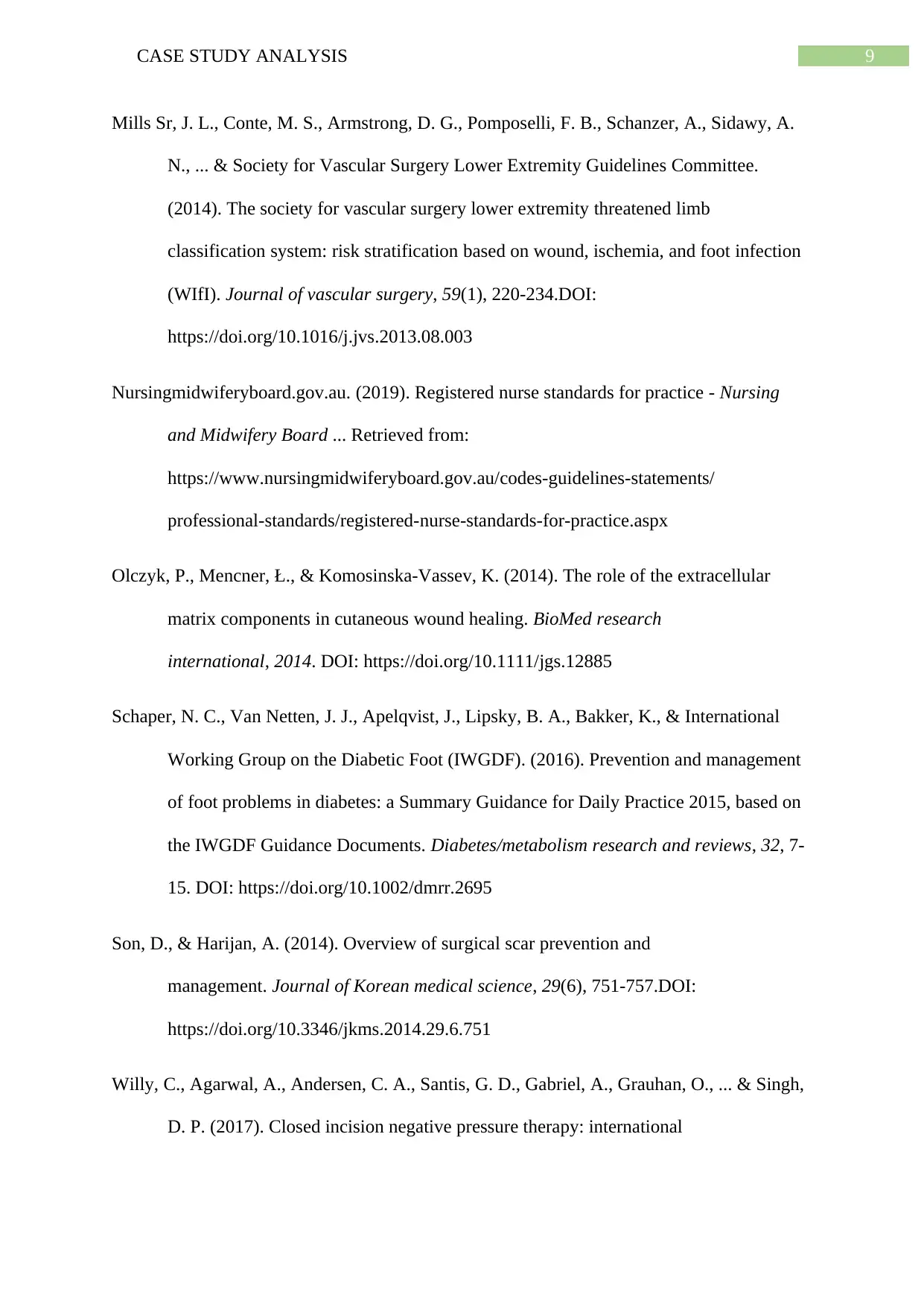
9CASE STUDY ANALYSIS
Mills Sr, J. L., Conte, M. S., Armstrong, D. G., Pomposelli, F. B., Schanzer, A., Sidawy, A.
N., ... & Society for Vascular Surgery Lower Extremity Guidelines Committee.
(2014). The society for vascular surgery lower extremity threatened limb
classification system: risk stratification based on wound, ischemia, and foot infection
(WIfI). Journal of vascular surgery, 59(1), 220-234.DOI:
https://doi.org/10.1016/j.jvs.2013.08.003
Nursingmidwiferyboard.gov.au. (2019). Registered nurse standards for practice - Nursing
and Midwifery Board ... Retrieved from:
https://www.nursingmidwiferyboard.gov.au/codes-guidelines-statements/
professional-standards/registered-nurse-standards-for-practice.aspx
Olczyk, P., Mencner, Ł., & Komosinska-Vassev, K. (2014). The role of the extracellular
matrix components in cutaneous wound healing. BioMed research
international, 2014. DOI: https://doi.org/10.1111/jgs.12885
Schaper, N. C., Van Netten, J. J., Apelqvist, J., Lipsky, B. A., Bakker, K., & International
Working Group on the Diabetic Foot (IWGDF). (2016). Prevention and management
of foot problems in diabetes: a Summary Guidance for Daily Practice 2015, based on
the IWGDF Guidance Documents. Diabetes/metabolism research and reviews, 32, 7-
15. DOI: https://doi.org/10.1002/dmrr.2695
Son, D., & Harijan, A. (2014). Overview of surgical scar prevention and
management. Journal of Korean medical science, 29(6), 751-757.DOI:
https://doi.org/10.3346/jkms.2014.29.6.751
Willy, C., Agarwal, A., Andersen, C. A., Santis, G. D., Gabriel, A., Grauhan, O., ... & Singh,
D. P. (2017). Closed incision negative pressure therapy: international
Mills Sr, J. L., Conte, M. S., Armstrong, D. G., Pomposelli, F. B., Schanzer, A., Sidawy, A.
N., ... & Society for Vascular Surgery Lower Extremity Guidelines Committee.
(2014). The society for vascular surgery lower extremity threatened limb
classification system: risk stratification based on wound, ischemia, and foot infection
(WIfI). Journal of vascular surgery, 59(1), 220-234.DOI:
https://doi.org/10.1016/j.jvs.2013.08.003
Nursingmidwiferyboard.gov.au. (2019). Registered nurse standards for practice - Nursing
and Midwifery Board ... Retrieved from:
https://www.nursingmidwiferyboard.gov.au/codes-guidelines-statements/
professional-standards/registered-nurse-standards-for-practice.aspx
Olczyk, P., Mencner, Ł., & Komosinska-Vassev, K. (2014). The role of the extracellular
matrix components in cutaneous wound healing. BioMed research
international, 2014. DOI: https://doi.org/10.1111/jgs.12885
Schaper, N. C., Van Netten, J. J., Apelqvist, J., Lipsky, B. A., Bakker, K., & International
Working Group on the Diabetic Foot (IWGDF). (2016). Prevention and management
of foot problems in diabetes: a Summary Guidance for Daily Practice 2015, based on
the IWGDF Guidance Documents. Diabetes/metabolism research and reviews, 32, 7-
15. DOI: https://doi.org/10.1002/dmrr.2695
Son, D., & Harijan, A. (2014). Overview of surgical scar prevention and
management. Journal of Korean medical science, 29(6), 751-757.DOI:
https://doi.org/10.3346/jkms.2014.29.6.751
Willy, C., Agarwal, A., Andersen, C. A., Santis, G. D., Gabriel, A., Grauhan, O., ... & Singh,
D. P. (2017). Closed incision negative pressure therapy: international
Secure Best Marks with AI Grader
Need help grading? Try our AI Grader for instant feedback on your assignments.
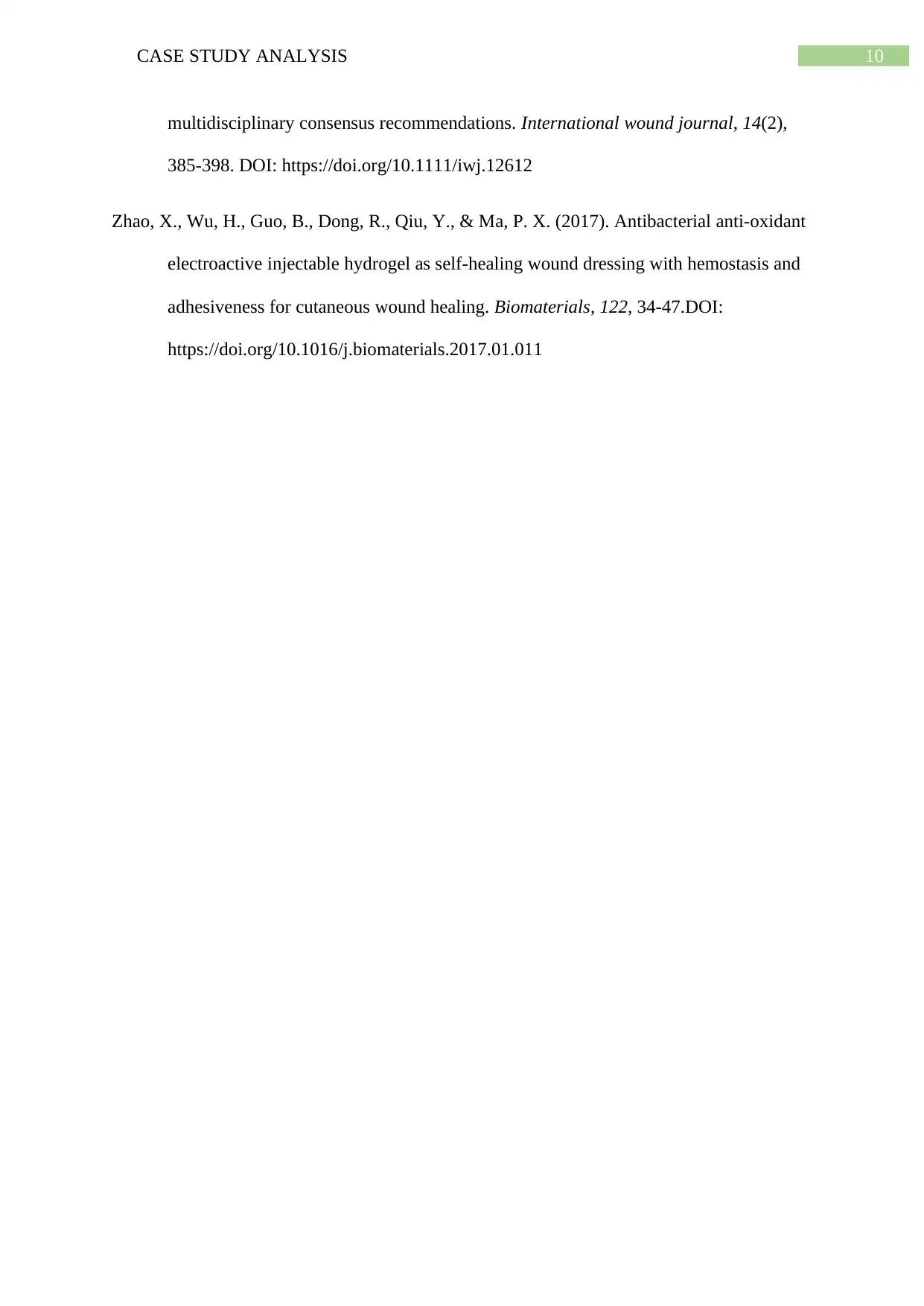
10CASE STUDY ANALYSIS
multidisciplinary consensus recommendations. International wound journal, 14(2),
385-398. DOI: https://doi.org/10.1111/iwj.12612
Zhao, X., Wu, H., Guo, B., Dong, R., Qiu, Y., & Ma, P. X. (2017). Antibacterial anti-oxidant
electroactive injectable hydrogel as self-healing wound dressing with hemostasis and
adhesiveness for cutaneous wound healing. Biomaterials, 122, 34-47.DOI:
https://doi.org/10.1016/j.biomaterials.2017.01.011
multidisciplinary consensus recommendations. International wound journal, 14(2),
385-398. DOI: https://doi.org/10.1111/iwj.12612
Zhao, X., Wu, H., Guo, B., Dong, R., Qiu, Y., & Ma, P. X. (2017). Antibacterial anti-oxidant
electroactive injectable hydrogel as self-healing wound dressing with hemostasis and
adhesiveness for cutaneous wound healing. Biomaterials, 122, 34-47.DOI:
https://doi.org/10.1016/j.biomaterials.2017.01.011
1 out of 11
Related Documents
Your All-in-One AI-Powered Toolkit for Academic Success.
+13062052269
info@desklib.com
Available 24*7 on WhatsApp / Email
![[object Object]](/_next/static/media/star-bottom.7253800d.svg)
Unlock your academic potential
© 2024 | Zucol Services PVT LTD | All rights reserved.




